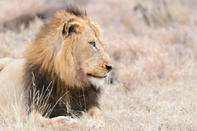The Pre-Restriction Era
Early visitors were given a relatively free hand in their new national park. Speeding motor vehicles kicked up huge clouds of dust as they hurtled through the reserve.

Ignorant of the danger, many foolhardy people got out of their cars and approached sleeping lions, eager for a closer look or even a pat. Driving at night was allowed and cars would often get stuck in the middle of the dark wilderness, far from any human eyes.
There were also many cases of animals being run down by speeding vehicles. Back in the rest camps, things were hardly restful. In the evenings, campfires were lit and gramophones were cranked up. Hours of singing, dancing and general merrymaking ensued, and one can only imagine what was going on in the windowless rondavels.
Visitor Explosion

Within a few years, the warden had issued regulations which put an end to much of this rowdiness. It was also decided to close the park during the hot summer months, as the visitor numbers were low and the chances of contracting malaria were high. Furthermore, the heavy rains of summer made the road network unpredictable and the rangers grew tired of rescuing cars and trucks that were stuck in the mud.
Only the Pretoriuskop area remained open all year round, as it lay in the foothills of the Drakensberg where the threat of malaria is reduced. This was done for the benefit of overseas visitors who enjoyed travelling to sunny South Africa during their icy winters. Whatever hassles may have been caused by rampant tourists, it was obvious that the park was a great success.
News of the unique game viewing experience in the Lowveld spread like wildfire through the press and by word of mouth. Visitor numbers exploded; 6000 cars and lorries carrying 26 000 people trundled through the gates in 1935 alone.
Shingwedzi Section Open

In 1931, the remote and often neglected Shingwedzi section was opened to the public. Formerly a lonely outpost, manned by only a single ranger and handful of native police, the northern part of the park was now considered to be worthy of exploration. The animals were unusual (including nyala, eland and elephant) and the scenery was attractive, with lush valleys cut through the hilly landscape by rivers rushing towards the great Limpopo.
By 1933, 100 miles of road had been constructed in Shingwedzi and a low-level causeway had been built over the Letaba River. It was now possible to drive an ordinary car from Malelane at the bottom of the reserve to the Luvuvhu River at the top. The Kruger National Park was open for business!
The Star Attraction

Many things were learnt during the first 5 years of the park’s existence. At first, it wasn’t known how the game would react to the sudden appearance of noisy, smelly cars full of noisy, smelly people – all belching smoke and dust. Several authorities were particularly worried that ravenous lions would attack the vehicles and maul the tourists.
To everyone’s relief, the animals paid the cars very little heed and continued with their business, much as before. Another surprise was that the lions quickly became the star attraction of the Kruger Park. Previously dismissed as vermin, the big cats proved to be of overwhelming interest to the city slickers – so much so that Piet Grobler issued James Stevenson-Hamilton with an order to stop his programme of culling lions. Stories of lion spotting quickly came to dominate campfire discussions, and little has changed.
Appreciation, Conservation and Education

Then, as now, the standard Game Reserve question ‘Did you see anything?’ really translates as ‘Spot any lion?’. This idolatry confounded James Stevenson-Hamilton who thought of lion as somnolent beasts who were intelligent but rather boring. He preferred the various antelope species, the original ‘game’ for which the Sabi Reserve had been declared. In many ways, the opening of the Kruger Park began a process whereby environmental awareness became part of popular culture in South Africa.
Before the Kruger Park, perspectives of wildlife were limited to their commercial or sporting value. Today, we have moved from a culture of exploitation to a culture of appreciation, conservation and education. Wildlife is now part of our heritage, and integral to our identity as South Africans. The role of the Kruger Park in entrenching this attitude cannot be understated.
By David Fleminger During the 1890s, things grew chaotic in the Republic of the Transvaal (present day Mpumalanga). Since the discovery of gold, Johannesburg h...
During the 1890s, things grew chaotic in the Republic of the Transvaal (present day Mpumalanga). Since the discovery of gold, Johannesburg h... The first intake of rangers, for the newly formed Sabi Reserve, which later became the Kruger National Park, was assembled on an ad-hoc basi...
The first intake of rangers, for the newly formed Sabi Reserve, which later became the Kruger National Park, was assembled on an ad-hoc basi...